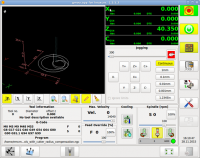GUI - internal code / HAL connect
- zz912
-
 Topic Author
Topic Author
- Offline
- Platinum Member
-

- Posts: 584
- Thank you received: 95
Disable cycle start / run button until conditions are met?
forum.linuxcnc.org/gmoccapy/49281-disabl...ons-are-met?start=10
inspired me to ask this question:
Why does the control part of the LCNC use HAL signals and the GUI part of the LCNC use internal code?
Why don't both parts of the LCNC use HAL signals?
As for internal codes, I see only disadvantages.
1) nothing can be changed without interfering with the source codes
2) when there is a bug in the source codes, you cannot use HAL show for diagnostics.
3) using, editing, repairing internal codes requires very specialized knowledge
Please Log in or Create an account to join the conversation.
- Aciera
-

- Offline
- Administrator
-

- Posts: 4618
- Thank you received: 2043
I have never written a GUI but if I did then I'm not sure I would want to add the extra complexity of having hal connections on top of the gui code just so users can customize it more easily.
However , I presume that one could create a python gui that creates hal pins.
Please Log in or Create an account to join the conversation.
- HansU
-

- Offline
- Platinum Member
-

- Posts: 697
- Thank you received: 212
Please Log in or Create an account to join the conversation.
- spumco
- Offline
- Platinum Member
-

- Posts: 1965
- Thank you received: 799
I've also wondered about this, but wasn't able to articulate it.
Why does the control part of the LCNC use HAL signals and the GUI part of the LCNC use internal code?
Why don't both parts of the LCNC use HAL signals?
My speculation is that somone who wants some new feature or function in LCNC would find it easier to create/modify LCNC's behavior through a GUI than to modify LCNC itself.
Upside: massive flexibility and options
Downside: end-users must learn multiple frameworks (LCNC + GUI) to be able to modify GUIs or even troubleshoot effectively
I'd rather there be a standardized HAL-only interface for GUI's, but changing LCNC to this framework would be, I suspect, an insurmountable hurdle.
All current GUIs would be broken to some extent. And an extensive expansion of HAL components would be necessary to duplicate functions available in GUIs and passed through via python.
Please Log in or Create an account to join the conversation.
- tommylight
-

- Away
- Moderator
-

- Posts: 21097
- Thank you received: 7205
I also consider the downside as an upside, the first thing i look for in anything new is flexibility.
Upside: massive flexibility and options
Downside: end-users must learn multiple frameworks (LCNC + GUI) to be able to modify GUIs or even troubleshoot effectively
I have separate laptops for separate stuff i do, 3 phones (only 1 number though) that i use daily, etc.
Keeping things compartmentalized
Please Log in or Create an account to join the conversation.
- cmorley
- Offline
- Moderator
-

- Posts: 7248
- Thank you received: 2110
Also the GUI side was built with the idea that multiple GUis could be connected at one time, though that capability in practice would be/is difficult now. Networked GUIs were possible and at the time, networked HAL was not available.
I don't immediately see the advantage of HAL for machine controller internal data.
HALshow displays most of the important internal data.
How could you reconnect the internal data in a meaningful HAL way without code changes anyways.
Still would need the specialized knowledge.
Good documentation of the internal code, switching to more common/standard libraries and using more python when appropriate would be very helpful to lower the bar of machine controller development.
Please Log in or Create an account to join the conversation.
- Aciera
-

- Offline
- Administrator
-

- Posts: 4618
- Thank you received: 2043
There is no need to break anything.All current GUIs would be broken to some extent.
Python components can already create hal pins. So if somebody wanted they could write a hal-connectable GUI right now.
Please Log in or Create an account to join the conversation.
- zz912
-
 Topic Author
Topic Author
- Offline
- Platinum Member
-

- Posts: 584
- Thank you received: 95
Thanks to both parties for speaking up. I would be happy if more people would express their opinion here.
My goal is to at least think about the HAL connect path.
[HansU]
If you would have a GUI where all buttons have to be connected via HAL would result in a huge additional HAL file and would make it just error-prone.
I think quite the opposite. At the moment, Gmoccapy has the following bugs:
github.com/LinuxCNC/linuxcnc/issues/2489
github.com/LinuxCNC/linuxcnc/issues/2453
github.com/LinuxCNC/linuxcnc/issues/2448
I devoted almost a month and a half to solving them. Zero result.
I have not spent more time on any other issue in LinuxCNC. When I solved problems with Mesa cards, encoders, stepgens, parrports, switch buttons, carousel, debouncing etc. so I solved these problems relatively immediately. I was always able to test each component separately or watch it in the HAL show or HAL scope.
Please Log in or Create an account to join the conversation.
- spumco
- Offline
- Platinum Member
-

- Posts: 1965
- Thank you received: 799
Thank you. My ignorance is generally limitless when it comes to GUIs, python, and most of the 'backstage' stuff in LCNC.
All current GUIs would be broken to some extent.
There is no need to break anything.
Python components can already create hal pins. So if somebody wanted they could write a hal-connectable GUI right now.
Please Log in or Create an account to join the conversation.
- newbynobi
-

- Offline
- Platinum Member
-

- Posts: 1930
- Thank you received: 393
But a GUI does a lot more that just representing widgets.
I.E. in my first gmoccapy release (just made for myself) the spindle buttons was active all the time, as I do know, that switching off the spindle while a program is running is not a good idea. After I published the GUI, a user mentioned a bug and claimed that his cutting tool was damaged due to my GUI. He clicked on the spindle Off button while the tool was cutting material. So I added a function to disable the button while a program is running, checking the "is Idle" status.
If a GUI is based only on hal, the user need to connect the button according to the interpreter state.
Have you ever tried that?
If you want to modify gmoccapy:
- Search for "_make_hal_pins" and add a Hal Pin
like:
pin = self.halcomp.newpin("run_button_check", hal.HAL_BIT, hal.HAL_IN)
hal_glib.GPin(pin).connect("value_changed", self._run_button_check_changed)add something like around line 2600:
def _run_button_check_changed(self, pin, type):
self.widgets.btn_run.set_sensitive(pin.get())all out of memory
Norbert
Please Log in or Create an account to join the conversation.
